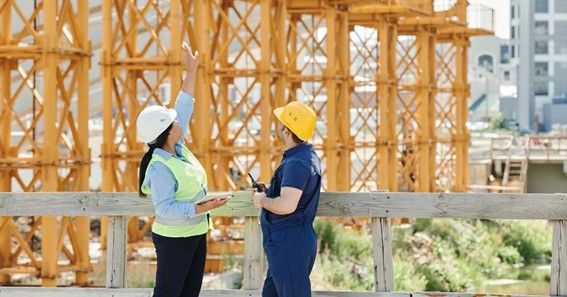Asbestos is the market term for naturally occurring fibrous materials composed of thin, tiny fibers. It has long been utilized in various products, such as insulators, fireproofing and construction materials due to its excellent heat resistance. However, asbestos can break down into tiny particles that can easily be inhaled. Inhaling the particles has been connected to mesothelioma, respiratory cancer, and other lung and breathing issues.
Since the health risks were revealed, the use of asbestos has decreased substantially. However, in many occupations, the exposure risk remains high despite its controlled use.
Asbestos exposure is a major concern in several industries. Shipbuilding, construction industry, refineries are only a few examples of high-risk occupations for asbestos exposure. Individuals who manufacture, install, or work on asbestos-containing machinery are always in danger of exposure.
When working with asbestos, there is no such thing as a safe level of exposure. And, sadly, countless workers have been affected by severe asbestos-related diseases. If you have recently been diagnosed with asbestosis or an asbestos-related disease, you may be entitled to cash compensation from the party that put you in danger.
Even if you were exposed to asbestos years ago and your former employer is no longer in business, you should consult with an experienced legal expert about making a compensation claim. If you live in the United States and are looking for a reputable firm, Sokolove Law is one of the best options available. If you are unsure what to do next or have questions about submitting a compensation claim, the team of experts at Sokolove Law will assist and support you throughout the process.
Click here – LMS – A must-have for Construction Industry
Occupations with High-Risk Asbestos Exposure
The following occupations pose a high risk of asbestos exposure to workers on the job site.
-
Aircraft Mechanics
Aircraft mechanics work on planes, choppers, and other airborne transport to ensure that their engines, mechanical elements, hydraulic systems, and other power parts are running smoothly and safely. Their typical job sites include hangars, maintenance centers, and airfields.
According to a study conducted in Naples and Rome, airplane maintenance and repair work involves significant asbestos exposure. Mechanics at the Rome and Naples airports were diagnosed with mesothelioma in multiple cases. Since many Navy and Airforce planes are equipped with asbestos for fire safety measures and sound insulation, military aviation mechanics face a high risk of exposure. Furthermore, from the 1930s to the 1980s, U.S. Air Force soldiers were exposed to asbestos because various components on planes contained asbestos at the time.
-
Carpenters
Carpenters work with wood and other materials used in the construction, repair and replacement of fixtures and structures including, stairs, cabinets, and dividers. Throughout the 20th century, carpenters employed asbestos-containing materials and tools. Though they were unaware of the risk at the time, these items put them at risk of developing serious asbestos-related illnesses such as cancer, lung disease, or mesothelioma.
Carpenters are at stake even now if they renovate or demolish older structures. While carpenters may have utilized asbestos-containing materials, they might have also been exposed to asbestos because of their contact with other tradespeople on the worksite using such products. Most carpenters do not have access to face masks or respiratory equipment to protect themselves from asbestos fibers and particles. They are not informed about the dangers of asbestos exposure either. And since many old houses still contain asbestos fibers, the risk of being exposed when repairing and renovating becomes higher.
-
Construction Workers
The fire-resistant qualities of asbestos make it particularly popular in the construction business. Before 1980, it was widely used in the construction of both residential and commercial structures. Asbestos was commonly found in insulation material, cement mixtures, and plasters. This put construction workers at a higher risk of being exposed while building, demolishing, or handling asbestos-based products.
According to the Centers for Disease Control and Prevention (CDC), construction workers are among those with the highest level of asbestos exposure. Approximately 1.3 million construction workers are exposed to asbestos on the worksite every year.
Because of public awareness of the health concerns linked with asbestos, its use has declined in recent decades. It is, however, still a danger to construction workers today. The majority of asbestos-related occupational exposure currently occurs when workers remodel, remove, or repair asbestos-containing products or buildings constructed centuries back.
-
Firefighters
Asbestos fibers can become airborne when buildings with asbestos construction material catch fire. Firefighters arriving to extinguish the fire can inhale the fibers without realizing the risk.
Thermal insulation, tiling, and roofing elements are all major asbestos products. The increased risk is largely due to repeated exposure during emergencies. For example, firemen who were exposed to poisonous dust on 9/11 may have health issues such as cancer in the future. Firefighters also perform prevention and control checks to ensure no dangerous incidents occur.
During these inspections, firefighters are directly exposed to burners, compressors, valves, heavy machinery, industrial equipment, and other things. All of these items contain a significant amount of asbestos, putting firefighters at a high level of asbestos exposure.
-
Electricians
Electricians install, repair, and maintain electrical equipment such as panels, power cables, electric motors, and generators in residences, commercial enterprises, factories, and power stations. They also repair the electrical systems on ships and railroads. Asbestos insulating materials are found in many electrical goods, including electrical cables, motor controllers, and electrical boards.
Most of this material was employed to insulate the products, while others were utilized to keep them safe from electrical sparks and fires. Moreover, while assisting other technicians in repairing such equipment, electricians might be exposed to asbestos. Electricians are still exposed to asbestos on construction projects, houses, buildings, factories, and while repairing electrical equipment. If an electrician suspects asbestos is present on a worksite, they should pause working until the area has been secured or proper protection gear has been provided.
Final Thoughts
Even though asbestos is supposed to be a thing of the past, it may still be present on many worksites. Workers in industries where asbestos-containing products may still be present should wear all of the protective equipment provided by their employers. It is critical to adhere to all safety measures and workplace policies to prevent health issues in the future.
Click here – What Is a Limit Order in Crypto Investing?





